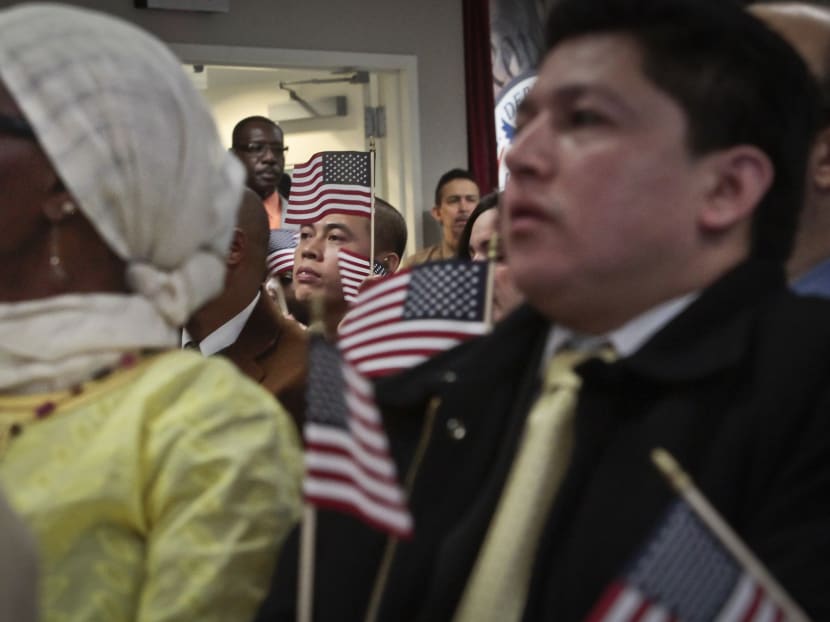Asians expected to become largest US immigrant group: Study
WASHINGTON — In a major shift in immigration patterns over the next 50 years, Asians will have surged past Hispanics to become the largest group of immigrants heading to the United States, according to estimates in a new immigration study.

In this Dec 18, 2013 file photo, immigrants hold miniature US flags as they listen to a video broadcast from President Barack Obama during a naturalisation ceremony. Photo: AP
WASHINGTON — In a major shift in immigration patterns over the next 50 years, Asians will have surged past Hispanics to become the largest group of immigrants heading to the United States, according to estimates in a new immigration study.
The study looks in detail at what will happen by 2065, but the actual tipping point comes in 2055.
An increase in Asian and Hispanic immigration also will drive US population growth, with foreign-born residents expected to make up 18 per cent of the country’s projected 441 million people in 50 years, the Pew Research Center said in a report being released today (Sept 28). This will be a record, higher than the nearly 15 per cent during the late 19th century and early 20th century wave of immigration from Europe.
Today, immigrants make up 14 per cent of the population, an increase from 5 per cent in 1965.
The actual change is expected to come in 2055, when Asians will become the largest immigrant group at 36 per cent, compared with Hispanics at 34 per cent. White immigrants to America, 80 per cent back in 1965, will hover somewhere between 18 and 20 per cent with black immigrants in the 8 per cent to 9 per cent range, the study said.
Currently, 47 per cent of immigrants living in the United States are Hispanic, but by 2065 that number will have dropped to 31 per cent. Asians currently make up 26 per cent of the immigrant population but in 50 years that percentage is expected to increase to 38 per cent.
Pew researchers analysed a combination of Census Bureau information and its own data to develop its projections.
Part of the reason for the shift is that the fertility rate of women in Latin America and especially Mexico has decreased, said Pew’s director of Hispanic research Mark Hugo Lopez. In Mexico, he said, women are now having around two children, when back in the 1960s and 1970s, they were having about seven children per woman.
“There are relatively fewer people who would choose to migrate from Mexico so demographic changes in Mexico have led to a somewhat smaller pool of potential migrants,” he said. “At the same time we’ve seen a growing number of immigrants particularly from China or India who are coming for reasons such as pursuing a college degree or coming here to work temporarily in the high-tech sector.” Despite the increase in Asian immigrants, Hispanics will still make up a larger number inside the United States, Mr Lopez said.
“Hispanic population growth is coming from people born here in the United States,” he said. “It is really US births that are now the driver of Hispanic population growth, and that’s a recent change from what we saw in the `80s and `90s.”
By 2065, no racial or ethnic group will hold a majority in the United States, with whites holding 46 per cent of the population, Hispanics at 24 per cent, Asians at 14 per cent and blacks at 13 per cent. Currently, the country is 62 per cent white, 18 per cent Hispanic, 12 per cent black and 6 per cent Asian.
Pew also asked Americans surveyed for one word to describe immigrants in the US today. Twelve per cent said “illegal”, “overpopulation” was at 5 per cent, “legality (other than illegal)” at 4 per cent, and “jobs”, “deportation”, “Americans” and “work ethic” at 3 per cent each. Forty-nine per cent offered general descriptions, and of those 12 per cent were positive, 11 per cent negative and 26 per cent neutral, according to the report.
Americans also said immigrants are likely to make the United States better, with 45 per cent agreeing with that statement and 37 per cent saying they make the country worse. Eighteen said they don’t have much of an effect one way or the other.
The survey was conducted online from March 10 to April 6, 2015. The survey’s margin of sampling error is plus or minus 2.4 percentage points. AP






